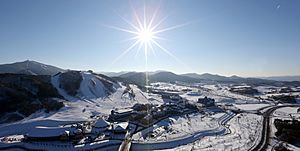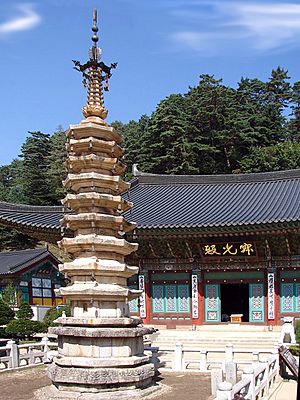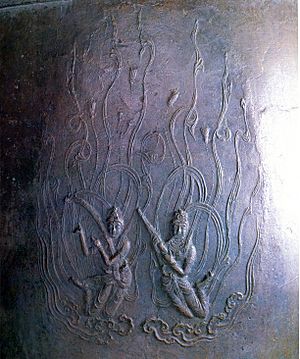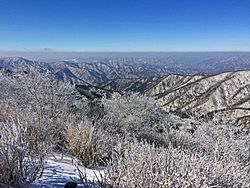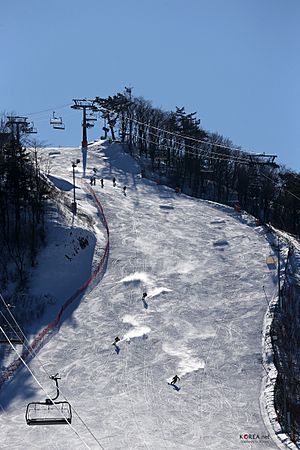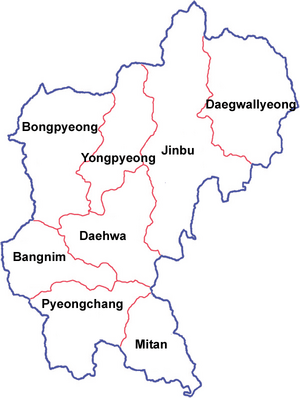Pyeongchang County facts for kids
Quick facts for kids
Pyeongchang
평창군
|
||
|---|---|---|
|
County
|
||
| Korean transcription(s) | ||
| • Hangul | 평창군 | |
| • Hanja | 平昌郡 | |
| • Revised Romanization | Pyeongchang-gun | |
| • McCune-Reischauer | P'yŏngch'ang-gun | |
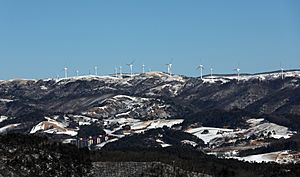
Alpensia Resort and a wind farm in Pyeongchang
|
||
|
||
| Etymology: 平 "peaceful" or "flatland", 昌 "prosperity" or "flourishing" | ||
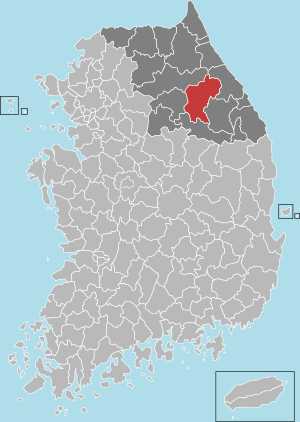
Location in Gangwon Province, South Korea
|
||
| Country | South Korea | |
| Province | Gangwon-do | |
| Administrative divisions | 1 eup, 7 myeon | |
| Area | ||
| • Total | 1,463.65 km2 (565.12 sq mi) | |
| Population
(2013)
|
||
| • Total | 43,666 | |
| • Density | 30/km2 (80/sq mi) | |
| • Dialect | Gangwon | |
| Time zone | UTC+9 | |
Pyeongchang (full name: Pyeongchang-gun) is a county in Gangwon-do, South Korea. It is located in the Taebaek Mountains area. This region is home to several Buddhist temples, including Woljeongsa. Pyeongchang is about 180 kilometers (112 miles) east of Seoul, the capital of South Korea. You can reach it easily by expressways and high-speed trains.
Pyeongchang's slogan is "Happy 700 Pyeongchang." This comes from its average elevation of about 700 meters (2,300 feet) above sea level.
Pyeongchang hosted the 2018 Winter Olympics and the 2018 Winter Paralympics. For these games, its name was officially spelled "PyeongChang" (with a capital 'C'). This was done to avoid confusion with Pyongyang, the capital of North Korea.
Contents
A Look at Pyeongchang's Past
The Pyeongchang area was once part of the Goguryeo Dynasty during the Three Kingdoms period. Back then, it was known as Uk-o-hyeon. Later, after the Silla dynasty took over, its name changed to Baek-o-hyeon.
When the Goryeo Dynasty began, the area was renamed Pyeongchang-hyeon. It was controlled by Wonju for a while. Over time, its administrative status changed several times. In 1299, it became independent from Wonju.
In 1392, the Joseon Dynasty was founded. Pyeongchang was then upgraded from a hyeon to a county (gun). It became part of Gangwon-do. These changes helped shape Pyeongchang into the area we know today.
Pyeongchang's Mountains and Weather
Pyeongchang is very mountainous. About 84% of its land is covered by mountains. The average height of these mountains is about 750 meters (2,460 feet).
The most famous part of Pyeongchang is Daegwallyeong-myeon. This area is usually between 700 and 800 meters (2,300–2,600 feet) above sea level. Some spots are even higher than 1,000 meters (3,300 feet).
Pyeongchang's Climate
Pyeongchang County has a humid continental climate with warm summers. This means its winters are long and get a lot of snow. The summers, however, are quite short.
From 2001 to 2010, the average temperature in Pyeongchang was 7.0 °C (44.6 °F). This is a bit cooler than the average for all of Gangwon. The area also gets a lot of rain and snow. The average yearly precipitation from 2001 to 2010 was 1,555.0 mm (61.22 inches).
The warmest months are July and August. The coldest months are January and February.
| Climate data for Daegwallyeong, Pyeongchang (1981–2010, extremes 1971–present) | |||||||||||||
|---|---|---|---|---|---|---|---|---|---|---|---|---|---|
| Month | Jan | Feb | Mar | Apr | May | Jun | Jul | Aug | Sep | Oct | Nov | Dec | Year |
| Record high °C (°F) | 8.7 (47.7) |
16.5 (61.7) |
19.7 (67.5) |
30.1 (86.2) |
31.0 (87.8) |
32.3 (90.1) |
32.9 (91.2) |
32.7 (90.9) |
29.0 (84.2) |
24.7 (76.5) |
21.5 (70.7) |
13.5 (56.3) |
32.9 (91.2) |
| Mean daily maximum °C (°F) | −2.5 (27.5) |
−0.4 (31.3) |
4.4 (39.9) |
12.9 (55.2) |
17.6 (63.7) |
20.5 (68.9) |
22.8 (73.0) |
22.8 (73.0) |
18.6 (65.5) |
14.0 (57.2) |
7.0 (44.6) |
0.5 (32.9) |
11.5 (52.7) |
| Daily mean °C (°F) | −7.7 (18.1) |
−5.5 (22.1) |
−0.5 (31.1) |
7.0 (44.6) |
11.9 (53.4) |
15.7 (60.3) |
19.1 (66.4) |
19.1 (66.4) |
14.1 (57.4) |
8.3 (46.9) |
1.3 (34.3) |
−4.4 (24.1) |
6.6 (43.9) |
| Mean daily minimum °C (°F) | −12.6 (9.3) |
−10.5 (13.1) |
−5.2 (22.6) |
1.2 (34.2) |
6.3 (43.3) |
11.2 (52.2) |
16.0 (60.8) |
16.1 (61.0) |
10.0 (50.0) |
3.1 (37.6) |
−2.8 (27.0) |
−9.1 (15.6) |
2.0 (35.6) |
| Record low °C (°F) | −28.9 (−20.0) |
−27.6 (−17.7) |
−23.0 (−9.4) |
−14.6 (5.7) |
−4.7 (23.5) |
−1.7 (28.9) |
4.4 (39.9) |
3.3 (37.9) |
−2.3 (27.9) |
−9.9 (14.2) |
−18.7 (−1.7) |
−24.7 (−12.5) |
−28.9 (−20.0) |
| Average precipitation mm (inches) | 62.6 (2.46) |
53.6 (2.11) |
75.6 (2.98) |
89.5 (3.52) |
122.3 (4.81) |
201.0 (7.91) |
326.7 (12.86) |
420.9 (16.57) |
307.3 (12.10) |
124.9 (4.92) |
76.9 (3.03) |
36.8 (1.45) |
1,898 (74.72) |
| Average precipitation days (≥ 0.1 mm) | 10.5 | 10.5 | 11.3 | 9.5 | 11.1 | 13.2 | 17.6 | 17.8 | 13.0 | 8.7 | 10.1 | 9.4 | 142.7 |
| Average snowy days | 13.0 | 11.8 | 12.0 | 3.3 | 0.2 | 0.0 | 0.0 | 0.0 | 0.0 | 0.8 | 5.2 | 10.9 | 57.2 |
| Average relative humidity (%) | 67.3 | 67.0 | 67.5 | 61.0 | 68.4 | 79.2 | 85.7 | 87.0 | 84.6 | 75.2 | 69.9 | 67.3 | 73.3 |
| Mean monthly sunshine hours | 197.2 | 185.2 | 202.3 | 226.6 | 229.4 | 179.8 | 138.1 | 130.7 | 143.9 | 193.3 | 176.4 | 191.9 | 2,194.8 |
| Percent possible sunshine | 64.4 | 60.8 | 54.6 | 57.4 | 52.1 | 40.7 | 30.8 | 31.0 | 38.6 | 55.5 | 57.8 | 64.3 | 49.3 |
| Source: Korea Meteorological Administration (percent sunshine and snowy days) | |||||||||||||
Culture and Fun in Pyeongchang
Important Cultural Sites
Pyeongchang has many important historical and cultural sites. The South Korean government has officially recognized 16 of these sites. The Gangwon Provincial Office has also registered 45 more.
These sites include:
- 5 National Treasures
- 5 Treasures
- 1 Historic Site
- 3 Natural Monuments
- Many other cultural items and buildings
Famous Temples
Pyeongchang is home to two very old and important Buddhist temples: Sangwonsa and Woljeongsa.
Sangwonsa is a temple on Odaesan Mountain. It was first built in 705. Even though the Joseon Dynasty did not support Buddhism, they still helped rebuild this temple many times. For example, King Taejong helped build a hermitage there in 1401. Later, King Sejo and his son, King Yejong, also supported the temple. During a battle in 1951, the temple was almost burned down, but a brave monk saved most of it.
Sangwonsa holds several important cultural items:
- The Bell of Sangwonsa (National Treasure No. 36)
- A wooden statue of the Manjusri Child (National Treasure No. 221)
Woljeongsa is another temple on Odaesan Mountain. It was founded by a monk named Jajang in 643. Like Sangwonsa, it has been rebuilt many times over the centuries. In 1951, 10 of its buildings were destroyed by fire. However, monks worked hard to restore it, and new buildings were gradually added.
Woljeongsa also has significant cultural items:
- The Octagonal Nine-story Stone Pagoda (National Treasure No. 48-1)
- A stone statue of the Bodhisattva (National Treasure No. 48-2)
Historic Archives
The Pyeongchang Odaesan Historic Archive is a very important place. It was one of five places where the official records of the Joseon Dynasty were kept. These records are called the Annals of the Joseon Dynasty.
Fun Festivals
- Daegwallyeong Snow Festival: This festival started in 1992. It's a winter wonderland with skiing, snowman making, and sledding. They've also added traditional games and snow car races.
- Hyoseok Cultural Festival: This festival celebrates Lee Hyo-seok, a famous Korean novelist. It takes place in the village where he grew up.
Interesting Museums
- Lee Seung-bok Memorial Hall: This hall remembers Lee Seung-bok, a young South Korean boy. It was built in 1982, and his house was restored in 2000.
Great Places to Visit
Odaesan Mountain is a beautiful place and a national park since 1975. It's home to the historic temples of Sangwonsa and Woljeongsa. Its highest point, Birobong Peak, is 1,563 meters (5,128 feet) high.
Pyeongchang has two big ski resorts that were used for the 2018 Winter Olympics:
- Alpensia Ski Resort: This resort has six slopes for skiing and snowboarding. Some runs are up to 1,400 meters (4,600 feet) long. It's open all year round and hosted most of the Olympic snow events. Alpensia also has a concert hall and an indoor water park.
- Yongpyong Resort: This resort has 28 ski slopes. It hosted the technical alpine skiing events during the Olympics.
Samyang Ranch is the largest highland farm in Asia. It's located in the hills of Daegwallyeong, high above sea level. You can visit it like a petting zoo and enjoy the beautiful countryside. This ranch is also famous as a filming location for popular dramas and movies.
Sports in Pyeongchang
Pyeongchang has hosted several major sports events. These include the 1999 Asian Winter Games, the 2013 Special Olympics World Winter Games, and the 2009 IBU Biathlon World Championships. Most famously, it hosted the 2018 Winter Olympics.
The 1999 Asian Winter Games
The 1999 Asian Winter Games were held in Gangwon Province, including Pyeongchang. About 799 athletes took part in these games. Events like alpine skiing, cross-country skiing, biathlon, short track speed skating, and figure skating were held in Pyeongchang.
The 2018 Winter Olympic Games
On July 6, 2011, Pyeongchang was chosen to host the 2018 Winter Olympics and the 2018 Winter Paralympics. It beat out other cities like Annecy, France, and Munich, Germany. This was a big win for Pyeongchang, especially after two previous attempts to host the games in 2010 and 2014.
The 2018 games were the third Winter Olympics held in Asia. The others were in Sapporo, Japan (1972) and Nagano, Japan (1998). Pyeongchang was the first place outside Japan in Asia to host the Winter Games.
As mentioned, for the Olympics, Pyeongchang was marketed as "PyeongChang" to avoid confusion with Pyongyang, the capital of North Korea. The main places for the 2018 Winter Olympics were the PyeongChang Olympic Plaza and the Gangneung Olympic Park. The 2018 Winter Paralympics also used these same venues.
Olympic Venues and Dream Program
To get ready for the 2018 Olympics, Pyeongchang built new hotels and the amazing Alpensia ski resort.
The region also has a special "2018 Dream Program." This program invites young people from countries where it doesn't snow. It gives them a chance to try winter sports for the first time.
The 2024 Winter Youth Olympics
Gangwon Province, which includes Pyeongchang, was chosen to host the 2024 Winter Youth Olympics. Many of the outdoor venues used for the 2018 Winter Olympics in Pyeongchang will be used again for these youth games.
Getting Around Pyeongchang
Pyeongchang County has good transportation links. The Gyeonggang Line (a train line) and the Yeongdong Expressway both run through the county from west to east. They connect Pyeongchang to the Seoul metropolitan region.
Trains
A new KTX high-speed train line, called the Gyeonggang Line, was built for the 2018 Winter Olympics. This line connects Pyeongchang to Seoul in less than 80 minutes. The line opened in 2017. KTX trains stop at Pyeongchang station and Jinbu station (which is close to the Olympic Stadium). More trains ran to Jinbu station during the 2018 Olympics.
Buses
- Intercity Buses: Pyeongchang Bus Terminal, Jangpyeong Bus Terminal, Jinbu Bus Station, and Hoenggye Bus Station are the main places to catch buses that go to other cities. Daehwa Bus Station also has intercity bus services.
- Local Buses: Local buses connect different communities within the county. They often start from Pyeongchang Bus Station, Jangpyeong Bus Terminal, and Jinbu Bus Station.
Pyeongchang's Local Areas
The county of Pyeongchang is divided into one town (called an eup) and seven townships (called myeon).
|
See also
 In Spanish: Pieonchang para niños
In Spanish: Pieonchang para niños



